The Vlachs: Metropolis and Diaspora
(Editor’s note: Asterios Koukoudis is the author of a recently published four-volume masterwork about the Aromanians: Thessaloniki and the Vlachs, The Vlachs of Olympus and the Meglen, The Vlachs of Veria and the Albanian Vlachs of Central Macedonia, and The Vlachs – Metropolis and Diaspora, which has been translated into English and will soon be available through the Society Farsarotul. The article below is drawn from that work’s first chapter, entitled “Introduction, assessment, and conclusions,” originally published in Thessaloniki in December 1997. Mr. Koukoudis will participate in the program at our Centennial Gala on July 5, 2003.)
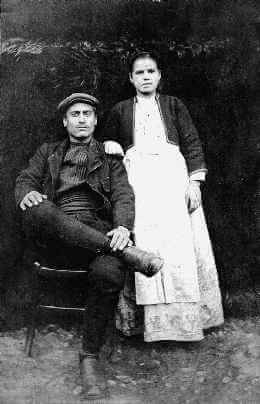
The author’s Vlach grandparents, Steryious Koukoudis and Chrysoula Zygouliana.
When I used to go to my mother’s village in Roumlouki, I remember how my Grekos grandad, barba-Dziordzi, would ask me: ‘What are you, lad, a Romios or a Vlahos?’. And in Veria, my Vlach grandad, lala-Steryios, would ask me in Vlach: ‘Tse χi tíni, Armîn ia Grek?’ (What are you, an Aroumanian or a Grekos?). And, anxious not to disappoint either of them, I would give each the answer he wanted to hear. It was years later that I realised that they both wanted me to say the same thing, but each wanted to hear it in his own language.
I remember when I was a little lad running about in the backstreets of Veria, my Vlach grandmother, teta-Hryssoula, wouldn’t turn her head or answer me if I called her yaya (‘granny’ in Greek) by mistake. She was absolutely determined that her grandchildren — even the children of her Greek-speaking daughters-in-law —should learn to call her mana mari (‘grandmother’ in Vlach).
Nor would she let us call lala-Steryios, her husband, pappou (‘grandad’ in Greek). She wanted us to call him afendi, which was the correct way for Vlach children to address their father’s father. Lala-Steryios liked us to call him afendi, but he didn’t insist on it. But since she couldn’t teach us to speak Vlach, teta-Hryssoula definitely wanted us to call her mana mari. Her insistence on this was even greater if we called her yaya by mistake in front of her Vlach friends in the neighbourhood where my father grew up. And she had her way. None of her grandchildren ever called her yaya. To us, even when she wasn’t there, she was mana mari, and that’s what we called her and how we referred to her, arousing the curiosity of people who didn’t know what mana mari meant. When I grew up and wanted to learn Vlach, I tried to persuade her to speak Vlach to me, but, as she said herself, it was too late. We couldn’t really have a proper conversation, and teta-Hryssoula would talk to me in Greek. It was only when she wanted to keep some little secret from my mother or when she was in a good mood that she’d speak to me in Vlach, hoping I’d understand. But she was right, it was too late.
It may have been too late for me to learn Vlach, but it wasn’t too late for me to learn more about the Vlachs. And I certainly didn’t go looking for them in opportunistic writings by ignorant outsiders with an axe to grind. For me, the Vlachs were a part of my very identity. So, like anyone seeking information about his recent or distant ancestry, I started looking for my roots. The scattered references to the Vlachs in various Greek history books weren’t enough. The information they gave me was often contradictory or even offensive to the Vlachs. And even more often, their perception of the Vlachs was stereotypical and coloured by their writers’ political views. This was one of my first disappointments. But it wasn’t long before I discovered some important works, some written quite recently, both in Greek and in other languages, that approached the Vlachs in a more understanding and objective way.
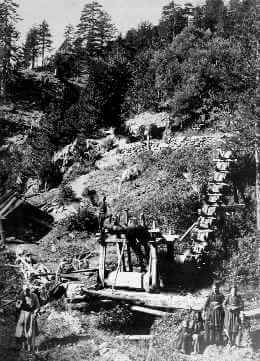
Water-saw, Vouvousa (Baieasa), early 20th century.
I decided to continue my investigations and learn more. So I began questioning my own relations and the more elderly people in my own Vlach environment. What struck me most was that there were clear divisions among the Vlachs, which had to do with their geographical origins and their family roots in specific villages, with early population shifts and exoduses, with the types of the villages and settlements, the Vlach dialect they spoke and their way of life, their economy and their social status, their environment and their ideological leanings. The idea of writing a book that would present all these divisions started to win me over.
The endeavour to record all the historical data about such a large number of villages and settlements is somewhat similar to the patient work of an expert conservator, finding and re-assembling the pieces of a fragmented Byzantine mosaic and restoring it to its original form. One has to develop a kind of spiritual relationship with one’s subject. It presupposes a knowledge of the Vlachs and their places, and a predisposition to dive back through time and mentally recreate the atmosphere and the style of past ages and other people’s lives. But also, the Vlachs still exist, and getting involved with them isn’t the same as getting involved with cultural groups and communities that have vanished into the mists of time. So one definitely needs a greater degree of sensitivity, a greater sense of responsibility. Furthermore, the researcher has to maintain an emotional distance from the subject to ensure impartiality. As I embarked on my endeavour, I hoped I’d be able to walk the fine line between what my heart told me on the one hand and what my intellect said on the other.
My research was carried out on three levels: i) literary research, ii) archival research, and iii) fieldwork and personal testimonies. My basic source of information was the writings of historians and history researchers of different generations and times. The accounts of such early nineteenth-century travellers as Pouqueville, Leake, and Holland were a valuable source, because they were written before the various forms of Balkan nationalism erupted with their concomitant propaganda movements. The information I gleaned from the works of nineteenth-century Greek scholars, such as Aravandinos and Lambridis, was also invaluable. Despite their errors, the works of Weigand, Wace and Thompson, Capidan, and Hâciu are still unrivalled, owing to the wealth of information to be found within their pages. Also valuable were certain Vlach-related works written at a time when no-one was interested in investigating and writing about the Vlachs, such as the writings of Sokratis Liakos, now a very old man indeed. Equally remarkable are two almost unknown books by Nikolaos Ziagos, who provides quantities of historical and socio-economic data relating to the identity of the Vlachs of the Pindos during the Byzantine and Ottoman periods. Among more recent works, I particularly appreciated the efforts of people whose monographs and almost unknown books have lovingly limned the stories of their own native villages.
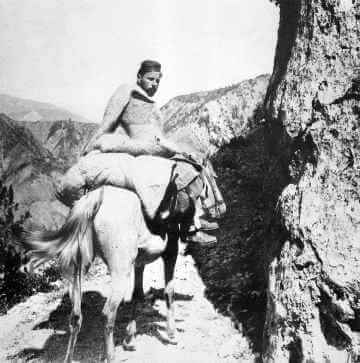
Muleteer, Vlahozagoro, 1928
Information gleaned from the literature was backed by research in: i) the Historical Archive of the Hellenic Foreign Ministry; ii) the Archive of the Governorate General of Macedonia; iii) the Archive of the Museum of the Macedonian Struggle in Thessaloniki; and iv) the Dragoumis Archives in the Yennadios Library. The Greek diplomatic and other documents of the nineteenth and early twentieth century revealed some unknown aspects of the subject and furnished masses of valuable information and knowledge, which helped me to interpret events, situations, and people’s personal decisions. The documents in the historical archives bear witness to who countless people were and what they achieved in their lives — mostly quite unknown people, but also some who played important roles as statesmen or as prominent forces in the country’s political, economic, and social life, both long ago and more recently. The various Greek writings about the Vlachs often try to glorify influential figures of Vlach descent, such as national benefactors and war heroes, who are really quite numerous in proportion to the Vlachs’ demographic strength. But when you investigate the documents in the archives, you often find yourself face to face with ordinary people, the anonymous Vlachs who are mentioned as mere statistical data. The attitude of these simple folk shows us another, almost completely unknown aspect of the Vlach identity, which is essentially no different from that of other groups of modern Greeks, though it could often be described as admirable. The identity of these ordinary Vlachs ought really to be quite an embarrassment to some of the past and more modern students of the Vlachs, not only because they ignored or were indifferent to the simple folk (and often to prominent Vlachs), but above all because they preferred to deal with the Vlachs by focusing on the exceptions rather than the rule.
My fieldwork and the personal testimonies I collected were the most interesting aspect of my research. The collective memory of the ordinary people came as the greatest surprise, because dozens of interviews confirmed numerous references in the literature and the archives and helped me to interpret details of the Vlachs’ modern history. They also cast light on unknown aspects of the local history of the villages and the various Vlach populations. Planned and chance meetings and interviews with dozens of women and men in the little coffee-shops in villages and provincial towns or in their hospitable homes or their workplaces were a joy and a delight throughout the course of the research. For a brief moment, these unknown, usually elderly people became witnesses to their cultural and historical heritage, and it’s mainly to them that I owe the most valuable knowledge about who the Vlachs are. I thank them from the bottom of my heart for having given me their time and for the confidence they showed in me.
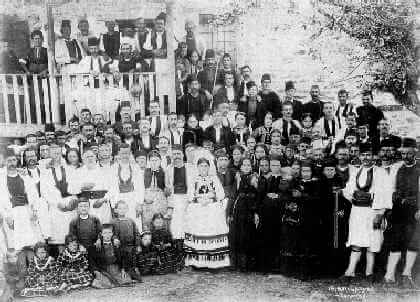
Snapshot from the wedding of the Bessios and Nassikas families, Samarina, 1902
I should also like to express my gratitude to the Administrative Board of the Museum of the Macedonian Struggle in Thessaloniki and to its chairman Mr Dimitrios Zannas for having welcomed my efforts with such interest and for the help they gave me. Special thanks are due to Dr Basil Gounaris and the other members of the Museum’s research department, who were invaluable colleagues. Without their scholarly and moral support, I could never have completed this project. I should also like to thank the Panhellenic Federation of Vlach Cultural Associations and the various local Vlach cultural associations for their interest and support throughout my investigations.
The span of time covered by this study varies from section to section. In the case of the ancestral villages along the Pindos (vol. 2: The Vlachs: Metropolis and Diaspora), the review starts with vague mediaeval references and ends in the late nineteenth and early twentieth century. Here I’ve collected and presented the scattered information about the development of the Vlach villages during the Ottoman period, with particular emphasis on the economic, social, and cultural aspects of the Vlach communities. This volume examines the Vlachs’ origins both as nomadic or transhumant stockbreeders and as ‘urban’ merchants and craftsmen, as also their demographic movements and diaspora throughout the Balkans until the early years of the twentieth century. In the case of the ancestral villages, I don’t examine the phenomenon of Romanian propaganda, which anyway is a much more recent development that’s been imported into the events of Vlach history. In the sections concerning the Vlach groups in Central Macedonia (vol. 1. Thessaloniki and the Vlachs; vol. 3. The Vlachs of Olympos and Moglena; and vol. 4. The Vlachs of Veria and the Arvanitovlachs of Central Macedonia), the chronological review runs from Roman and mediaeval times to after the Greek Civil War. These sections offer a more detailed analysis of Romanian propaganda and the more recent evolution of the Vlach populations in Central Macedonia.
I chose to concentrate on Central and Eastern Macedonia because these areas were not only home to older Vlach centres and groups representing the Vlach diaspora from almost all the highland centres along the Pindos, but also the starting-point for new settlements and summer and winter homes for nomadic and semi-nomadic groups from all over the area. Furthermore, all forms of Vlach settlement (nomadic, transhumant, agricultural, semi-urban, and urban) have existed here, together with all possible ideological trends. Had I extended my analytical investigation to other geographical areas too, I could certainly have gathered more data about the various Vlach villages and settlements; but my conclusions would have been the same. In fact, if I’d included Epiros and Thessaly, the fundamental picture of the Greek — or at least the modern Greek — dimension of the Vlachs’ identity would have been strengthened even further.
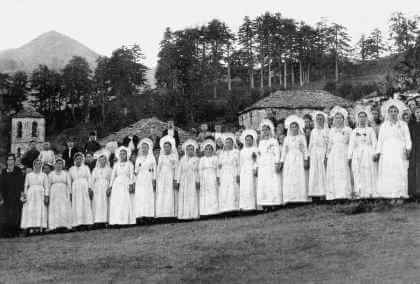
The brides of the year, Smixi, 1924
A number of theories and opinions have been expounded regarding the Vlachs’ origins and ancestry. Unfortunately, many of them reflect a romantic and rather desperate quest for a glorious past and illustrious forebears; and they are closely tied up with political agendas and Balkan outpourings of nationalism, particularly Romanian aspirations and the Greek counter-arguments. The subject of this study isn’t the distant ancestry of the Vlachs; because whatever their ancestry is, it doesn’t seem to have played any particular part in their more recent evolution. The fundamental subject of this study is the Vlachs themselves, and it focuses on who the Vlachs are, not what they are. Apart from the indisputable fact of the Vlachs’ existence, my main objective is to show how the Vlach-speaking populations have lived with and integrated with their Greek-speaking and non-Greek-speaking fellow-travellers, and also to illustrate their very important contribution to the shaping of Romiosyni (Editor’s note: Romiosyni is one of the senses of Greek self-identity, especially in the centuries before modern Hellenism took root) and the creation of modern Greece and the modern Greek identity. In these pages it becomes clear that it is the Vlachs’ recent history (17th–20th centuries) that has been most important and played the biggest part in determining their identity. I’ve written this study in such a way that it can serve as a kind of reference book, in which readers may seek discrete information about the specific population group, the village, or the settlement that interests them. So a certain amount of overlapping and repetition is inevitable.
The stereotypical concepts about the Vlachs are full of myths and fictions, most of which have grown out of the chequered history of the Vlachs themselves. It’s my intention to demolish a number of these, the most baseless of which is that the Vlachs are a small, marginal group of traditional, uncultured, nomadic stockbreeders. However similar they may seem, there’s a clear distinction between vlahos with a small v (used simply to mean a ‘shepherd’ in modern Greek) and Vlahos with a capital v. Certainly, the various Vlach groups have included smaller groups directly connected with various forms of stockbreeding, connections which go back to the deep Middle Ages. But the presence of Vlach farmers, merchants, craftsmen, and professionals is far from negligible. When the Vlach population groups began gradually to make their presence felt in the Balkans in the early seventeenth century, they appeared not only as nomadic shepherds, but also as itinerant traders, merchants, craftsmen, professionals, and retailers, and also as very capable fighters in the form of armatoles and klefts. Earlier studies overlooked the decisive nature of the Vlach population groups’ social and economic development, though it attracted the interest of foreign travellers as early as the late eighteenth and early nineteenth century. Ultimately, the Vlachs’ origins as ‘urban’ merchants and craftsmen seem to go back just as far as their roots as nomadic or transhumant stockbreeders. In fact, their urban class is as old as, or older than, that of many other Balkan groups.
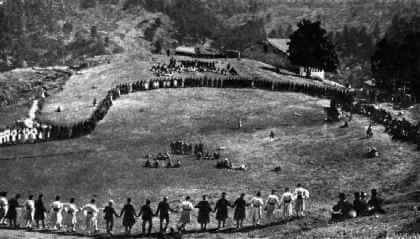
The Great Dance, Avdella, 1927
A great deal of fiction also permeates the Vlachs’ nomenclature. We mustn’t overlook the fact that the vast majority of the Vlachs, both within and beyond the borders of Greece, refer to themselves as Armînu, pl. Armîńi (Aroumanians), a term which has the same root as Romios pl. Romii, which is what the Greek-speaking populations called themselves until the term Ellinas pl. Ellines (Greeks or Hellenes) reasserted itself. All the other names that are applied to the Vlachs were given to them by their various neighbours. Even the name ‘Vlachs’ was originally given to them by the Germanic-speaking invaders in the Balkans, who used it of the various Latin-speaking populations generally. The Slavonic-speakers took it over from the Germanic-speakers, and it was eventually adopted by the Byzantines and later by the Ottomans. Terms such as Koutsovlach, Bourdzovlach, Karavlach, Gog, Čoban, and Cincar carry pejorative overtones and are offensive to the Vlachs, though Cincar has in fact acquired nuances of class and distinction, particularly in the more northerly parts of the Balkans. Significantly, Spyridon Vlahos, Archbishop of Athens, commented to Alexandros Svolos: ‘Anyone who uses the term Koutsovlach is himself a koutso-writer’ (koutsos = ‘lame, limping’). In this study I’ve opted to use the term ‘Vlach’ rather than ‘Aroumanian’ or ‘Armînu’, because this is how the Vlachs refer to themselves nowadays when speaking Greek. Furthermore, ‘Vlach’ is used and understood in the other Balkan languages, whereas ‘Aroumanian’ is almost unknown outside specialist and, of course, Vlach circles.
I must also explain some other terms used in this study, such as Grekos/Gréku (pl. Greki/Grétsi; fem. Greka, pl. Grekes). To a Vlach-speaker, the Greki are all the Christians whose mother tongue is one of the Greek dialects that have been spoken in the Balkans down the ages. In many cases, however, the term ‘Grekos’ has carried political overtones and been used of individuals, groups, or whole populations who, although their mother tongue wasn’t Greek, were supporters, in the nineteenth to twentieth century, of the ‘Hellenic idea’, the sense of belonging to the Greek, or at least the modern Greek, nation. The term ‘Grecoman/Grikumánu’ is an extension of those political ideas. It essentially meant a non-Greek-speaking but fanatical supporter of the ‘Hellenic idea’, and was used as a term of abuse by the rival factions. The term ‘Romaniser’ was equally pejorative, and was applied to people who were allegedly blind followers of Romanian propaganda. As for the compound Ellinovlachos (Greek-Vlach), it clearly carries both cultural and political overtones. Although Ellinovlachos and Grekovlachos were used from the early nineteenth century onwards, before the various propaganda and nationalist movements exploded onto the Balkan scene, nowadays it seems otiose to define the Vlachs as ‘Greek’ in this way. I shall never forget what I heard from the simple people who gave the wisest, clearest answers to my questions, drawn from their own profound experience. Barba-Kostas Ziogas in Perithori near Kato Nevrokopi was one, and he told me: ‘Look, lad, the Greki aren’t more Greek than we are. We may be Vlachs, they may be Greki, but all together we make up the Greeks.’
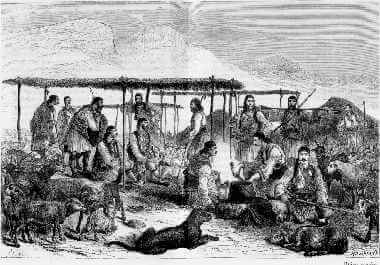
Karagun Arvanitovlach (Farsharot) pastoral nomads,
Mt. Kallidromo, Roumeli, 1874
The Vlachs always had clear names for the other inhabitants of the Balkans. In accordance with the same political perception based on experience, they referred to all the Balkan Moslems as ‘Turks’; though they did distinguish certain non-Turkish-speaking groups among the Moslems, such as the Albanian-speaking Tourkalvani or Arnauts, the Slavonic-speaking Pomaks and Karagovalis, the Greek-speaking Valaades, and the Moslem Vlach-speaking inhabitants of Notia in Moglena. Regarding their Slavonic-speaking Orthodox Christian neighbours, they recognised the existence of Bulgarians and Serbs, but also that of the Slavonic-speaking ‘Grecomans’. The Vlach inhabitants of Kruševo in Fyrom still use the term Vîrgari (Bulgarians) of their fellow townsfolk who are descended from Slavonic-speaking families. The Vlachs call the Albanian-speaking Orthodox Christians Arbinesi, and it was under this name that the ancestors of the modern Albanians first appeared in the Middle Ages.
There’s a mistaken view that the Sarakatsani/Sărăkătšăńi are linguistically Hellenised Vlachs. It was first presented and cultivated by pro-Romanian writers, but is difficult to support with documentation. It also looks like an attempt (one of many) to strengthen the artful impression that the Vlach populations were much greater than they really were. In the end, the Sarakatsani are simply Greek-speaking fully nomadic groups of stockbreeders who are also known as vlahi with a small v. This is further supported by the fact that the Vlachs themselves regard them as Greki, and that the Sarakatsani refuse to define themselves as Vlachs with a capital v. After all, there have been nomadic and semi-nomadic stockbreeding populations of other linguistic groups in the Balkans besides the Vlach-speakers for at least the past three centuries (18th–20th), because nomadism and transhumance have never been the exclusive prerogative of Vlach-speakers. Nor must we forget that most of the Vlachs’ linguistic assimilation has taken place not in the mountains, where they have, after all, dominated, but in agricultural villages on the plains and in the vicinity of large and small economic, urban, and administrative centres.
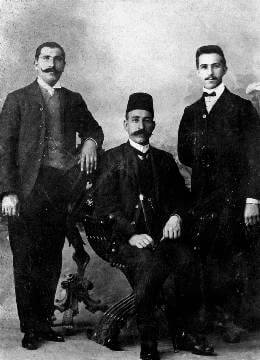
Theodoros Dodos (center), Nicholas Dodos (right),
Alexandria, Egypt, early 20th century
As for the artificial terms ‘Macedono-Vlachs’ and ‘Macedo-Romanians’, which have been applied to the Vlachs, not only are they unsuccessful political neologisms, they’re also unfair to the Vlachs. For Vlachs have always existed way beyond the geographical limits of Macedonia, most notably in Thessaly, Epiros, and Albania. This study makes it clear that the present diaspora of people of Vlach origin throughout the Balkan countries is the result of comparatively recent population shifts. While ‘Vlach populations’ are presented as milling about over the length and breadth of the central Balkans in the Middle Ages and the Byzantine period, the consolidation of Ottoman rule coincided with a rearrangement of these mediaeval ‘Vlach’ population groups and their villages and settlements. Until 1769, which was the date of the first collapse of Moschopolis and marked the start of some major exoduses and diasporas, the only surviving Vlach populations were in the south-west Balkans, along the Greek peninsula. Prior to that, the older and mediaeval ‘Vlach populations’, who lived to the north and east of a notional line running from Durrës, across Mount Pelister, and through Moglena to Thessaloniki, seem to have been assimilated and disappeared. The older and mediaeval ‘Vlach populations’, whoever they were, in Thrace, Bulgaria, Serbia, Kosovo, northern Albania, Montenegro, Bosnia, Herzegovina, and as far as Dubrovnik (Ragusa) on the Dalmatian coast had already died out. One typical example of this process is the disappearance of the mediaeval ‘Vlach populations’ of the Asanid dynasty, who had lived in what is now Bulgaria, probably based in the Balkan Mountains (Stara Planina).
It should be noted here that, on the basis of linguistic criteria, the Morlachs Maurovlachs), a Latin-speaking group on the coast and in the immediate hinterland of Dalmatia who disappeared a century ago, must be regarded as a different entity from the Aroumanian Vlachs. And two more Latin-speaking groups which still survive south of the Danube are also separate from the Vlachs. The first, the Cici or Ciribiri, known also as Istro-Romanians, are located in Istria in Croatia, are very small, and are in the process of dying out. The second, the Vlaši or Timoceni are located mainly in the wider area of the River Timok in eastern Serbia and appear to be Romanians. Be all this as it may, there were at one time large concentrations of Vlach groups and settlements south of the aforementioned notional line. After 1769, however, this spatial distribution of the Vlachs was broken up, and constant comings and goings carried them down to the Rodopi and the Balkan Mountains, and also to various towns in modern Bulgaria. They inundated almost the entire geographical area of Macedonia, settling both in the mountains and in the towns, and going as far as towns in Serbia, Kosovo, and Bosnia. Crossing the Danube and the Sava, they set up colonies in the Habsburg Empire and the Danubian Principalities. They also spread southward, down to Attica. Major Vlach centres, such as Kruševo in Fyrom and Serres in Eastern Macedonia, are the result of this late and somewhat overlooked Vlach diaspora.
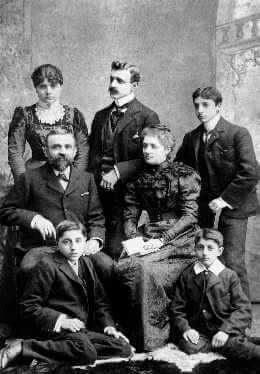
A family from Nymfaio in London, late 19th century
However, since there can be no diaspora without a point of departure, it seems reasonable to look for the original Vlach centres. There can be no doubt that from at least the Middle Ages until shortly after the mid-eighteenth century, the Vlach centres were concentrated along the Pindos range and its offshoots. The oldest and most densely inhabited Vlach villages survive today only on the flanks of the Pindos, from Pelister to Dzoumerka and Koziakas. The Vlach villages in the areas of Aspropotamos, Vlahodzoumerko, Metsovo, Grevena, Vlahozagoro, Konitsa, Grammos, Western Macedonia, Moschopolis, Dangëlli, and Kolonjë were the Vlach centres until around 1769. The Vlach villages in the region of Mount Olympos belong with these centres, despite the distance which separates them from the Pindos. The Moglena Vlachs too must be regarded as an original group, even though some scholars believe them to be of different provenance and despite the differences between them and the rest of the Vlachs. The people of Vlach origin who now live in Eastern Macedonia, Bulgaria, most of Fyrom, Kosovo, and Serbia know that their ancestors came from one or other of these ancestral centres. Even the people of Vlach origin who now live in Romania, and particularly those in Dobrudja, are known to have arrived there en masse mainly in the period between the wars.
The point of scrutinising the Vlach diaspora is to offer an alternative approach to the Vlachs’ very identity. A study of the Vlachs is not a study of an absolutely distinct linguistic group moving about in space and time, but the actual history of the gradual linguistic Latinisation and de-Latinisation of the southern Balkans, with all its local mutations and in direct connection with environmental adaptation and the cultural division of labour. Population shifts and diaspora have been constant features of the Vlachs’ history, possibly as significant as their Latinate speech. We should regard as their primary shift, or rather displacement, their ascent into the mountains when the Slavs arrived and settled. Once there, they took advantage of the geography, their somewhat unusual relations with the central authority, and the abundant resources available at that particular time, and emerged vigorously onto the stage of history as pillars of the commercial, industrial, and military establishment in the Balkans. These were two complementary aspects of the initially pastoral orientation of their highland communities which put the Vlachs at the top of the traditional social pyramid in the Ottoman-ruled Balkans.
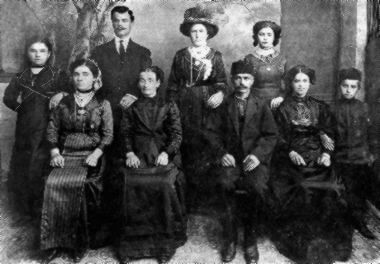
Family of Theodoros Vafeas, Bitola,
Early 20th century.
The economic, social, and cultural system of the tselingato or stockbreeding clan, together with the commercial and light industrial orientation and the varied economy of the Vlachs’ mountain communities were the seedbed in which strong traditional values, ideas, and perceptions were cultivated. A long line of heroic traditional warriors, powerful leaders and local notables, political figures and successful itinerant traders, merchants and craftsmen, capitalists and national benefactors, literary figures and spiritual leaders were born in the Vlachs’ highland communities and tselingata. Although in some cases, movement and diaspora led to assimilation, more often than not the Vlachs’ mobility strengthened them and helped them to survive as a distinct ethno-cultural or ethno-linguistic group, because their movement was accompanied by changes which made the most of the political, economic, and social circumstances. Their association with the highlands should not be perceived as indicating a hermetically sealed remote society. Far from it, the centuries-old evolution of their ancestral centres in the mountains seems to have given the Vlachs the best opportunities to distinguish themselves. In the end, it was the economic and social evolution of the various Vlach groups and not their linguistic identity or their provenance that determined their relations with their neighbours, particularly the rest of the Greeks.
At the dawn of the twentieth century, the Vlach villages fell into two fundamental, but not clearly distinct categories, on the basis of their economy: 1) villages with an economy based largely on stockbreeding; and 2) villages with an economy based largely on commerce and craft-trades. Although the pastoral populations seem to have constituted the Vlachs’ rootstock for many generations, in modern times, at least since the mid-seventeenth century, large groups of Vlachs have earned their living as settled or itinerant traders, merchants, craftsmen, professionals, and farmers too. Most of the Vlach villages were inhabited all the year round, and the transhumant summer residents were the exception rather than the rule. As for the fully nomadic Vlach populations, like most of the Arvanitovlachs and the Grammoustian Vlachs, they were very much a minority in comparison with the Vlach villages and settlements with a permanent population of ‘urban’ merchants and craftsmen. Although the nomadic and semi-nomadic Vlachs rather looked down on agriculture, it was a supplementary economic activity. Farming was the cornerstone of the Moglena Vlachs’ economy. In the final analysis, the Vlach settlements sustained a genuinely mixed economy. One might be based on animal husbandry with some craft-trades, another on commerce and craft-trade with some agriculture and stockbreeding; but almost everywhere livestock was reared and its products used at least at a domestic level. (1) The comparative autonomy of their highland communities, (2) their mixed economy, (3) direct access to raw materials, (4) commercial knowledge and craft-trade skills, (5) the accumulation of capital, (6) the inevitable seasonal movement with the flocks and herds, and (7) their long eventful journeys with the caravans brought the surplus Vlach population into the towns and led to the development of a third category of Vlach settlements, the very dynamic colonies in the urban, administrative, and economic centres. The Vlachs’ genius as merchants and craftsmen that was born in the mountains served them even more effectively in the dozens of colonies that grew up in almost all the towns in mainland Greece and the most important of the larger villages on the plains and in the foothills. In an age when the Balkans knew no borders, the restless Vlachs constituted a very significant — though in terms of their population disproportionate — part of the basis for the development of the bourgeoisie in a host of Greek Orthodox communities, not only in the territory of what is now the Greek state, but also in the neighbouring Balkan countries. These colonies seem to have played a very decisive role in more recent Vlach developments.
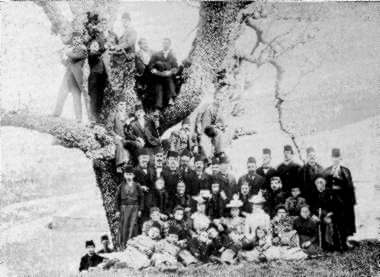
Group from Trnovo, early 20th century.
In the nineteenth century, both the Vlach villages with a commercial, light industrial, and ‘urban’ economic basis and those that were more directly involved in various forms of stockbreeding were large prosperous communities, at least in comparison with the neighbouring villages and estates dwelt in and worked by the smallholders and tenant farmers of other linguistic groups. And wherever the Vlachs cohabited with other groups, they usually held high positions in the local economic, social, and cultural class system. There were exceptions, of course, such as the Vlach villages in Moglena and the hut settlements of the exclusively nomadic Vlach stockbreeders. The interest of many researchers has focused on the pastoral Vlachs, and they have rather neglected the equally numerous, but settled, merchants and craftsmen. One of the direct effects of this has been to reinforce the stereotypical misperceptions about the Vlachs. The examples of Vlach communities. in and around such Central and Eastern Macedonian towns as Katerini, Servia, Veria, Naoussa, Edessa, Aridaia, Gevgelija, Serres, Iraklia, Alistrati, Nevrokop (Goce Delčev), Prossotsani, Drama, Hryssoupoli, and especially Thessaloniki come as a great surprise to most people and show how little they know about who the Vlachs really are.
When one examines the Vlachs’ shifting demographic situation, it becomes clear that after the Balkan Wars (1912–13) the vast majority of the Vlachs (two-thirds according to Weigand) became Greek citizens, in addition to their existing identity as integral members of Romiosyni, the modern Greek nation. In 1912–13, of the 160,000 or so Vlachs whom Weigand estimated to be living in the Balkans at the end of the nineteenth century, 102,330 were in Greece, 30,830 in what is now Fyrom, 13,465 in Albania, and about 10,000 in Bulgaria, Serbia, Kosovo, and Bosnia. However, Weigand’s demographic records are by no means complete or absolutely correct, like others from the same period (such as the statistics provided by the Oecumenical Patriarchate). A completely different and certainly exaggerated picture is presented by the demographic reports and population figures drawn up by pro-Romanian writers (such as Margaritis and Rubin, and Boga), in which the deliberately inflated numbers conflict sharply with both the Slav (Bulgarian and Serbian) and the official Ottoman-Turkish statistics. So if we compare the disparate demographic reports and bear in mind certain unknown or little-known statistical data, it’s not hard to arrive at the firm conclusion that the Vlachs numbered at least 200,000 at the beginning of the twentieth century, and probably no more than 220,000.
But if we then investigate which Vlach villages and settlements were liberated and incorporated into Greece at that time, we find that not only the majority of the Vlach people, but all the ancestral Vlach villages (apart from the decadent Moschopolis (Voskopojë) and a few other exceptions, such as Gopeš and Malovište) now became an integral part of Greece. On the slopes of the Pindos alone, from Grammousta to Pertouli, there are still eighty or so Vlach villages, despite the far-reaching impact of the twentieth century. But the demographic presence of the Vlachs on Greek territory isn’t confined to a few remote highland areas. Varying concentrations of Vlach groups, great and small, are to be found from Xanthi in Thrace to the island of Corfu and from the mouth of the Aheloös to the mouth of the Sperhios. In contrast to the picture of Vlach demographics in the other Balkan countries, in Greece a host of more recent Vlach communities in the plains and in the urban economic and administrative centres co-exist with the numerous mediaeval highland ancestral homes of all the Vlachs.
It’s a fact that a number of historians and students of the Vlachs have ignored the historical background out of which the modern Greek nation emerged. Since they ignored or overlooked the Roman and Byzantine periods, it’s no wonder that they disregarded the Vlachs too. And it was only to be expected that a variety of self-appointed saviours and patrons should seek to claim the Vlachs out of this limbo. But in the end, despite indifference and often rejection, the Vlachs have emerged by their own efforts as a valuable component of modern Greek history and the modern Greek identity. The history of the Vlach populations is an inseparable part of the modern Greek experience and at the same time an important chapter in Balkan history. Without a doubt, the Vlachs are one of the fundamental vehicles of the Balkan dimension of modern Greece, a dimension which is sometimes disregarded and sometimes extolled. But when Vlach-related issues come to be regarded as taboo, then the most serious risk is that the Vlachs will start to feel alienated from their own space and their own homeland. Yet this sense of alienation conflicts with their collective memory, which has always identified them with Romiosyni. The Vlachs’ journey from the Ottoman millet-i-rüm to the re-establishment of the Greek nation was essentially no different from that of other groups, whether Greek-speaking or not, who in the same period (19th–20th century) found themselves taking part in the nation-building ferment and changes which helped to shape the modern Greek identity. This book makes it clear that, although there have always been Vlachs in the other Balkan countries, the osmotic processes that have taken place in the Balkans in the past few centuries mean that they are now a manifestly (modern) Greek ethno-cultural or ethno-linguistic entity.
Apart from conclusions about the evolution of the Vlach populations and their villages and settlements, it’s also worth mentioning some conclusions relating to the phenomenon of Romanian propaganda. First and foremost, it must be undertsood that the Romanian propaganda is a very recent, imported development in the history of the Vlachs. Furthermore, it was never an independent movement of the Vlachs’, but was born and developed in a context of Romanian nationalism. It made its hesitant début in around 1860 and didn’t really start to gain ground until the first decade of the twentieth century, during the most critical period for the fate of the Ottoman provinces in the Balkans. Many of the studies that have dealt with the phenomenon have ignored its social and economic aspects. Those who supported this Romanian movement were usually less economically and, often, culturally advanced than most of the Vlachs who remained loyal to the millet-i-rüm. Like the other propaganda movements of the rest of the Balkan, and also European, countries, the Romanian propaganda was based on money and promises, and it seized its opportunities wherever it could among the less privileged Vlachs.
If we trace the creation, the rise, and the consolidation of the Romanian movement in the Balkans, we see that it was especially fortunate in the case of Avdella. Many of the pioneers of the movement, such as Averkios the monk and Apostolos Margaritis (Apostol Margarit), hailed from Avdella, and so the propaganda met with strong support in that Vlach village as early as 1860. Via family relations, which were a very important factor in the relations among the nomadic and transhumant Vlach clans in those days, the propaganda was able to spread to Avdella’s colonies on Vermio, in Klissoura, and also in Eastern Macedonia, where the movement was able to gain a foothold only in Ano Poroia, through a group of poor nomadic and transhumant stockbreeders who hailed originally from Avdella. The propaganda exploited the social system of the tselingato and tried to win over the more prominent tselingades and thus to impose itself on the dependent and independent shepherds. And so it was that the Arvanitovlach clans in Central Macedonia, and in the Korçë area too, followed the lead of some of the chief tselingades and found themselves supporting the propaganda — though the case of Ano Vermio testifies to the resistance of even the least privileged and least cultured Arvanitovlachs.
In the ‘urban’ Vlach societies based on commerce and craft-trades, the Romanian movement found opportunities for support from Vlach immigrants in Romania and individuals and groups that were in political, social, or economic conflict with the local leaders and proponents of Greek views. In some cases, the agents of the Romanian aspirations were actually described as ‘economic or social wrecks’, though with considerable ambition and drive, which was boosted by the Romanian propaganda. The propaganda very often exploited local disputes, social or economic strife, and even family quarrels, the most typical case being its exploitation of the economic, social, and political conflict between the Vlachs and the Greki of Veria. It supported and was backed by people who wanted to protect or expand their own interests. They were frequently people with a talent for politics, whose personal ambitions found an outlet and hopeful prospects in the propaganda’s aims. Furthermore, personal or collective gain was often a strong motivating force behind the choices that were made, and this applied not only to the Vlachs, nor yet only in the period under discussion.
Of course, the choices made at that time were profoundly influenced by the pressure applied and the tactics employed by the various Greek, Bulgarian, and Romanising partisan groups, as also by the divide-and-rule strategy of the Ottoman authorities. Particularly among the economically and culturally ‘weaker’ Moglenite Vlachs, the abundant Romanian cash and the close collaboration between the Romanian propaganda and the Bulgarian komitadjis were the two factors that determined the success of the propaganda in Moglena; though it’s true that it met with strong resistance even there. Certainly, the prolonged confrontations and the bloody strife of this period (1900–10) intensified the fanaticism of all the factions. In most cases, however, whether they were wealthy merchants and craftsmen or poor stockbreeders and farmers, the Vlachs were longing for some way of at least defusing the situation.
Even after a millet-i-ullah (a Vlach (not ‘Romanian’) administrative division), was recognised in 1905, the Vlachs didn’t hasten to make the most of the opportunity the Ottoman authorities had offered them, as the Bulgarians had exploited similar opportunities in the past. This was because most of the leaders of the local Vlach communities traditionally embraced the ‘Hellenic idea’ and identified their own progress with that of the still tiny Greece. Romanian propaganda failed to gain a foothold among the Vlachs of Eastern Macedonia, for instance, whether settled or nomadic, the reason being that the local communities all recognised the Vlachs as fundamentally modern Greeks. The movement failed likewise in the Vlach villages on Olympos, where neither the notables nor the ordinary folk felt themselves to be any different from the Greki in terms of their modern Greek identity. Particularly in the areas of the Pindos (Aspropotamos, Metsovo, Vlahodzoumerko, Vlahozagoro, Konitsa, Grevena, Grammos), Olympos, and Askio, (1) the identical modern history of the Greki and the Vlachs, (2) their joint participation in the armatoliks, (3) the Greek War of Independence in 1821 and later rebellions (1854, 1878), (4) the Vlachs’ prominent role in the local economy and culture, (5) their shared evolution, and (6) their shared political sentiments meant that the propaganda fell on stony ground indeed. There’s no clearer illustration of this identification than the fate of the village of Koutsoufliani after the Greek–Turkish War of 1897, when the inhabitants elected to burn their houses down and cross over into Greek territory.
The Vlachs and the Greki may be two separate linguistic groups, but the rest of their cultural differences, at least in the areas where they’ve been in constant contact for centuries, have probably never been of great significance, indeed have been a negligible factor in their cohabitation and their shared history. When all’s said and done, the Vlachs’ assimilation in the Greek areas has been more linguistic than collectively cultural. The existence of the Arvanitovlachs seems to confirm a similar but lesser degree of diffusion between the Vlachs and the Arvanites. By contrast, in areas where Vlach population groups have found themselves among Slavs, they seem to have resisted assimilation more strongly — though certain aspects of the cultural identity of the Moglenite Vlachs seem to indicate an earlier process of osmosis between this small and distinctive Vlach-speaking group and its Slavonic-speaking neighbours.
Certainly, for groups like the Vlachs, linguistic assimilation may herald their extinction. Yet the Vlachs themselves have played a part in the loss of their language, wherever they were. Modernism has been a much greater enemy of linguistic survival than the attitude and policies of the authorities. The language and a stronger sense of Vlach identity have continued to survive in groups, societies, and communities with a lower economic and social status, such as among the pastoral nomads and their descendants, than among the Vlachs living in more urbanised and prosperous villages and groups. The amazing thing about the language is that it still survives today in areas and villages with a stable and collective ‘Grecoman’ outlook, contrary, perhaps, to what one might expect. Wherever Vlach descent hasn’t been frowned upon but has come to carry a certain kudos among Vlachs and non-Vlachs alike, the language too hasn’t been frowned upon and has been able to survive much better. This probably confirms the view that the confrontations were one of the basic reasons why the language died out in areas and villages where the Vlachs were divided into warring factions. By the same token, the language failed to survive better, nor was the Vlach identity greatly advanced, in groups, societies, and communities where the Romanian movement cultivated supporters until the end of the Second World War.
After 1912-13, the fixing of the borders between the various Balkan countries weakened the Vlachs’ mercantile spirit and hindered the seasonal movements of some transhumant groups. The abolition of the çiftlik system foreshadowed the fate of the tselingato. Stockbreeding ceased to be the main source of wealth for a large proportion of the Vlach population. Political developments after 1912-13 seem to have exacerbated the economic problems and caused a certain initial confusion, among the ‘Grecoman’ Vlachs at least, because the official state’s recognition of a ‘Koutsovlach minority’ seemed to vindicate the Romanian propaganda. The diplomats and politicians who drew up the Treaty of Bucharest were more or less indifferent to the Vlachs’ history and the stated inclination of the vast majority of them, preferring to sacrifice them in order to safeguard crucial national interests and territorial and economic exchanges. So it’s not over-melodramatic to say that, in 1913, the Vlachs found themselves playing the tragic role of Iphigenia. But it wasn’t long before tragedy was joined by antiphrasis and oxymoron, as the Vlachs were collectively stigmatised for choices and actions not entirely their own. The essentially Romanian, not Vlach, communities continued to operate in Greece until the end of the Axis Occupation and the Second World War. They weren’t so active in Albania and Bulgaria; and in Yugoslavia, despite the agreements, they ceased to exist after 1918. The exodus of Vlachs from Greece to Romania in the interwar period gathered pace only among the transhumant communities of Central and, to an extent, Eastern Macedonia, as also among the poverty-stricken Vlachs of Moglena. This wave of emigration was more a consequence of the restructuring of the economy after the arrival of the refugees from the Asia Minor Disaster, and was a localised phenomenon, counterbalanced by a mass influx into Greece of Vlach refugees from Albania, Serbia, and Bulgaria from 1912 onwards. Furthermore, those who left for Romania between the wars didn’t necessarily support the propaganda. Most were desperate people ruined by problems that had been going on for decades. The exodus to Romania was localised and limited, because we know that the transhumant Vlachs of other areas, such as the Pindos, Olympos, and Askio, didn’t follow it, for their economy doesn’t seem to have been so badly affected. Furthermore, they had the foresight to carefully examine the proposals for emigration to the then inhospitable steppes of Dobrudja. The Vlachs from the more commercial and industrial villages and settlements were even more indifferent to these mass exoduses. The truly mass departure of the Grammoustian Vlachs from Bulgaria to Romania in this period seems to have resulted from the two countries’ disagreement over the territory of Southern Dobrudja. Another serious factor was that the Greek–Bulgarian border ran between their highland hut settlements and their traditional winter grazing grounds.
At this point, I should like to make some more general points. Ordinary Vlachs today regard their Vlach identity as a matter of ancestry, not national or ethnic vindication. Among the older ones, you’ll rarely meet anyone who doesn’t regret the loss of the language among the younger generation, and its apparently doomed path to extinction. The vast majority of the Vlachs are proud of their ancestry, whatever it may be, or whatever they believe it to be. But this pride doesn’t spring from a sense of national or ethnic difference; it’s a result of the position they held in past times, when the Vlachs, their villages, and their communities enjoyed a high social and economic status in the Balkans. Furthermore, their collective memory has retained the traumatic feeling that their contribution to Greek history hasn’t been fully appreciated, and this has strengthened their traditional pride even more. Any ‘militant views’ are expressed monopolistically by ‘irredentist circles’ abroad who lost touch with the Vlachs’ real position in Greek society decades ago. However much they may ‘love’ and ‘care about’ the Vlachs, they surely cannot know better than the Vlachs themselves the position they hold in, and the contribution they’ve made to, Greece’s evolutionary processes. Even so, the most unfair and unrealistic attitude towards, and treatment of, the Vlachs comes not from these weak and declining circles abroad, but from the wariness, the frequently negative attitude, and the often tragic ignorance of Greek policy-makers, whether of Vlach or non-Vlach origin. As long as the international community regards the ‘irredentists’ abroad as the only source of information about Vlach-related issues, any problems that exist will be perpetuated. The state is no less responsible for the current role of these ‘irredentist circles’, and ignorance doesn’t justify its attitude, especially in the eyes of the simple, ordinary Vlachs. For simple people, simple things might be enough.
The Europeans who take an interest in the Vlachs, like the Great Powers who did so in the past, are no less responsible for some of their problems. Their attitude at the beginning of the twentieth century, together with the complexities of the various axes they had to grind, exacerbated the difficulties which the Vlachs, like the rest of the Balkan peoples, were struggling with. The Europeans weren’t innocent of the destruction that was visited upon a large number of Vlach villages and settlements during the First World War. In quite a number of the villages, the Bulgarian forces actually took the opportunity to launch systematic and indiscriminate pogroms against both the Vlach and the Grek inhabitants. During the three Bulgarian occupations of Eastern Macedonia (1912–13, 1915–18, 1940–4), the Grek and Vlach populations underwent the same tragic experiences; and the fate of the Vlachs of Pelagonia during the First World War was no less dire. One of the most significant indications of the fundamental belief that the Vlachs were Greeks was the destruction of more than fifty flourishing Vlach villages during the Axis Occupation. In late 1943 in particular, but also throughout 1944, the German occupation forces partially or totally ruined Vlach villages from Mount Païko to Pogoni, Zagori, Aspropotamos, and Mount Olympos. Very few escaped unscathed.
The Vlachs who lost their lives in these mopping-up operations and other events were certainly far more numerous than the Vlach collaborators and traitors. In the final analysis, the German, Bulgarian, and Italian occupation forces treated the Vlachs no differently from the rest of the Greeks, since they obviously regarded them as all Greeks together. The Germans in particular, who had made racial discrimination the cornerstone of their policy, couldn’t have failed to know who the inhabitants of the villages they destroyed were. So the superficial concern with the activities of the notorious ‘Legion’ would seem to be dubiously motivated, especially if one bears in mind that the Vlachs were at the same time taking part in the various National Resistance groups, often in prominent positions.
My entire research has shown that various manifestations of nationalism and propaganda have left bitter echoes in the collective memory of the Vlachs. Given that the truth about the Vlachs and Vlach-related issues has been more or less systematically distorted by all those involved, it’s easy to understand why the Vlachs’ traditional reticence has increased, as also why most of them are suspicious of anyone claiming to be interested in them. In conclusion, it must be stressed that the Vlach Greeks, like their relations beyond the Greek borders, desire peace, prosperity, and progress more than anything else, and are entitled at the very least to our interest, understanding, and affection.
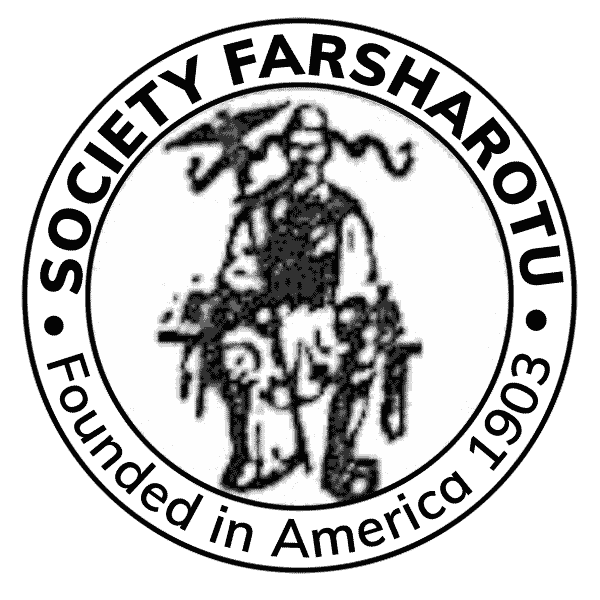
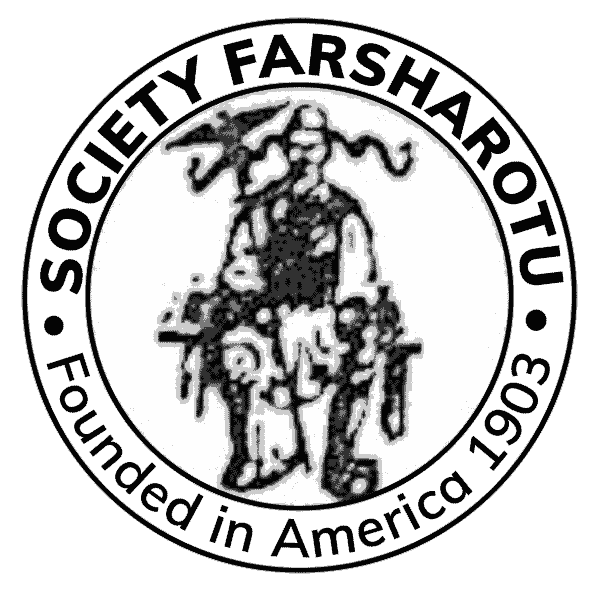
Responses